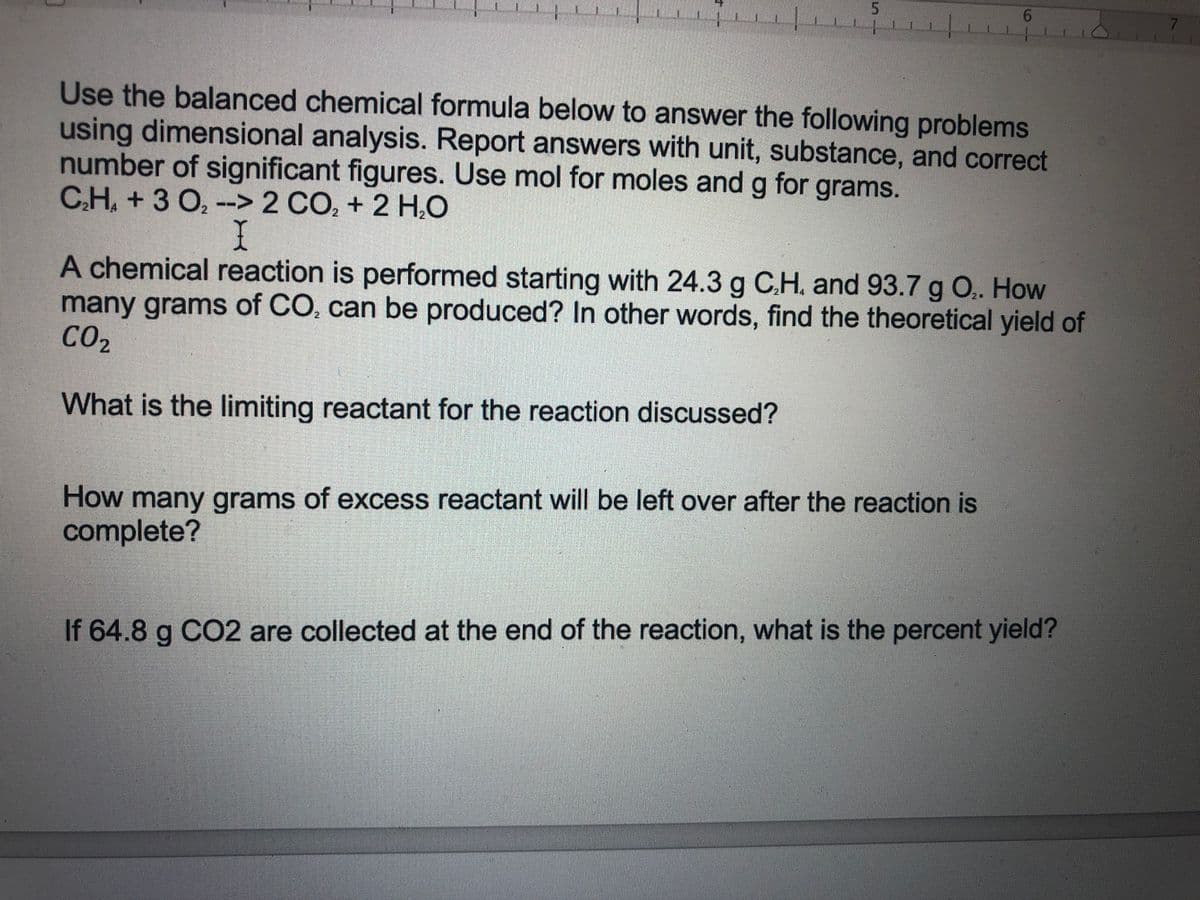Use the balanced chemical formula below to answer the following problems using dimensional analysis. Report answers with unit, substance, and correct number of significant figures. Use mol for moles and g for grams. C.H, + 3 O, --> 2 CO, + 2 H,O A chemical reaction is performed starting with 24.3 g C.H. and 93.7 g O.. How many grams of CO, can be produced? In other words, find the theoretical yield of CO2 What is the limiting reactant for the reaction discussed? How many grams of excess reactant will be left over after the reaction is complete? If 64.8 g CO2 are collected at the end of the reaction, what is the percent yield?
Use the balanced chemical formula below to answer the following problems using dimensional analysis. Report answers with unit, substance, and correct number of significant figures. Use mol for moles and g for grams. C.H, + 3 O, --> 2 CO, + 2 H,O A chemical reaction is performed starting with 24.3 g C.H. and 93.7 g O.. How many grams of CO, can be produced? In other words, find the theoretical yield of CO2 What is the limiting reactant for the reaction discussed? How many grams of excess reactant will be left over after the reaction is complete? If 64.8 g CO2 are collected at the end of the reaction, what is the percent yield?
Chemistry
10th Edition
ISBN:9781305957404
Author:Steven S. Zumdahl, Susan A. Zumdahl, Donald J. DeCoste
Publisher:Steven S. Zumdahl, Susan A. Zumdahl, Donald J. DeCoste
Chapter1: Chemical Foundations
Section: Chapter Questions
Problem 1RQ: Define and explain the differences between the following terms. a. law and theory b. theory and...
Related questions
Question

Transcribed Image Text:5.
7.
Use the balanced chemical formula below to answer the following problems
using dimensional analysis. Report answers with unit, substance, and correct
number of significant figures. Use mol for moles and g for grams.
CH, +3 O, --> 2 CO, + 2 H,O
A chemical reaction is performed starting with 24.3 g C.H. and 93.7 g O.. How
many grams of CO, can be produced? In other words, find the theoretical yield of
CO2
What is the limiting reactant for the reaction discussed?
How many grams of excess reactant will be left over after the reaction is
complete?
If 64.8 g CO2 are collected at the end of the reaction, what is the percent yield?
Expert Solution
This question has been solved!
Explore an expertly crafted, step-by-step solution for a thorough understanding of key concepts.
This is a popular solution!
Trending now
This is a popular solution!
Step by step
Solved in 3 steps

Knowledge Booster
Learn more about
Need a deep-dive on the concept behind this application? Look no further. Learn more about this topic, chemistry and related others by exploring similar questions and additional content below.Recommended textbooks for you

Chemistry
Chemistry
ISBN:
9781305957404
Author:
Steven S. Zumdahl, Susan A. Zumdahl, Donald J. DeCoste
Publisher:
Cengage Learning

Chemistry
Chemistry
ISBN:
9781259911156
Author:
Raymond Chang Dr., Jason Overby Professor
Publisher:
McGraw-Hill Education

Principles of Instrumental Analysis
Chemistry
ISBN:
9781305577213
Author:
Douglas A. Skoog, F. James Holler, Stanley R. Crouch
Publisher:
Cengage Learning

Chemistry
Chemistry
ISBN:
9781305957404
Author:
Steven S. Zumdahl, Susan A. Zumdahl, Donald J. DeCoste
Publisher:
Cengage Learning

Chemistry
Chemistry
ISBN:
9781259911156
Author:
Raymond Chang Dr., Jason Overby Professor
Publisher:
McGraw-Hill Education

Principles of Instrumental Analysis
Chemistry
ISBN:
9781305577213
Author:
Douglas A. Skoog, F. James Holler, Stanley R. Crouch
Publisher:
Cengage Learning

Organic Chemistry
Chemistry
ISBN:
9780078021558
Author:
Janice Gorzynski Smith Dr.
Publisher:
McGraw-Hill Education

Chemistry: Principles and Reactions
Chemistry
ISBN:
9781305079373
Author:
William L. Masterton, Cecile N. Hurley
Publisher:
Cengage Learning

Elementary Principles of Chemical Processes, Bind…
Chemistry
ISBN:
9781118431221
Author:
Richard M. Felder, Ronald W. Rousseau, Lisa G. Bullard
Publisher:
WILEY